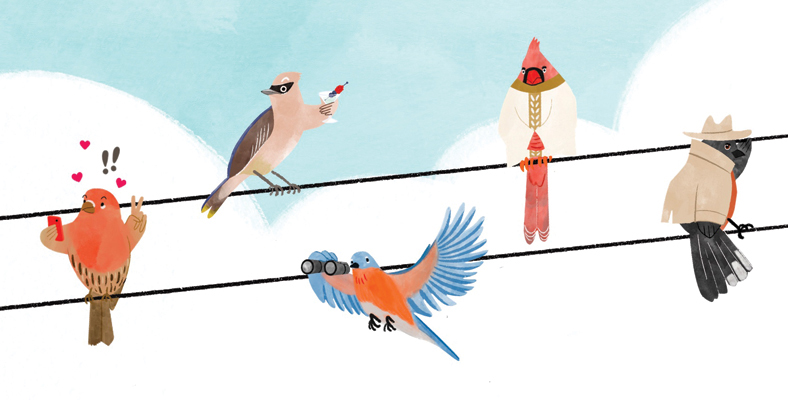
Dhananjaya Katju’s avian affinity took flight in the 1980s when, on a whim, he joined a birdwatching club in his native India.
“The birds I saw that day were like jewels with wings,” he says, a hint of awe still in his voice. “It was like, ‘How haven’t I seen this in all the years I’ve been living in the city?’”
Today, Katju, a professorial lecturer in the Department of Environmental Science, is opening Eagles’ eyes to some of the 350 species that call our city home. Students in his Urban Bird Conservation course explore the challenges winged Washingtonians face, including outdoor cats and other predators; light pollution, which can disorient birds and cause collisions with buildings; and noise pollution, which can stifle the songs used to attract a mate or alert the flock to danger.
The class is based on what Katju—a former urban ornithologist with the DC Department of Energy and Environment—says some critics consider a bird-brained premise: even in the city, nature abounds.
“One of the biggest issues from an instructional and even a scientific standpoint is that urban systems often aren’t considered ecosystems in the true sense of the word. People think wilderness and nature are out there,” says Katju says, waving his arm. “It’s in Yellowstone and Glacier [national parks].”
But in fact, he says, DC’s ecosystem boasts incredible avian diversity, from Mr. President and Lotus, bald eagles that live atop a tulip poplar at the US National Arboretum, to a pair of tropical roseate spoonbills spotted wading in Kenilworth Park and Aquatic Gardens in July. More pedestrian species—hummingbirds, herons, and hawks; swans, swallows, and sparrows; wrens, warblers, and wood thrush, the District’s official bird since 1967—also nest in the city.
The Fish and Wildlife Service estimates there are 45 million birdwatchers in the US. Katju knows not all of his students will join their binocular-toting ranks, but he hopes his class will inspire them to look out and look up.
“Birds just make the world more interesting.”
Something to crow about—take a gander at 10 of DC’s most popular birds:
House Finch: Once limited to the western US and Mexico, a handful of these birds, then dubbed “Hollywood finches,” were released on Long Island in 1939 by a pet store owner who couldn’t sell them. Today the species’ long, twittering song can be heard in all 50 states. Gregarious and social, they’re even considered an invasive species in some parts of the county.
Cedar Waxwing: Perhaps no bird works harder than the female cedar waxwing, who takes six days—and more than 2,500 trips—to build her nest. Named for the waxy red tips of their secondary feathers, cedar waxwings can subsist almost entirely on fruit. (They can even get intoxicated on overripe berries—not a bad way to end a hard day’s work for mama bird.)
Eastern Bluebird: This eagle-eyed bird can spot an insect on the ground from 60 feet away, swooping down to scoop up a cricket, caterpillar, or grasshopper before returning to its preferred perch on a power line or fence to wait for its next snack. These royal blue beauties build small, cup-like nests inside old woodpecker holes to protect their eggs from chipmunks and flying squirrels.
Northern Cardinal: A perennial favorite among backyard birders, the male of the species reminded early European settlers of the cardinals of the Roman Catholic Church—high-ranking bishops who wear red robes and caps. (Perhaps that’s why a group of northern cardinals is called a Vatican.) Even the females, which are a more muted brown with warm red accents, are stunners.
Eastern Towhee: If you want to spot one of these striking sparrows, look down. The solitary and secretive species, known for its scratchy chewink call, prefers to lay low—literally—in the brush, where you’ll likely hear its industrious scratching among the leaf litter before you catch a glimpse of its distinctive reddish-brown markings. Eastern towhee populations are on the decline as development continues to encroach on forestlands.

Blue Jay: This common songbird—known for its noisy call and ability to mimic predators and even people—is credited with spreading oak trees after the last glacial period and stockpiles up to 5,000 acorns each fall. Blue jays are monogamous and boast a longer lifespan than other birds (7–20 years in the wild), with mates growing old together in the small familial groups that migrate as a unit.
Northern Flicker: Known as the “anteater of the sky,” this member of the woodpecker family is an avian Orkin Man, using its unusual, curved bill to keep pesky insects at bay. Plentiful across North America, the eastern brood features a pop of yellow on the underside of their wings and tail, while the western clan sports a splash of red.
Baltimore Oriole: Like a soaring homerun to the upper deck, the Maryland state bird likes to perch high in the treetops, feasting on fruit and berries (the Halloween-hued songbird has a serious sweet tooth). The oriole was known across the Mid-Atlantic as the “Baltimore bird” in the 1700s—a nod to the heraldic crest of England’s Baltimore family, for whom the Old Line State’s largest city is named.
Red-Bellied Woodpecker: With their zebra-striped backs and neon red caps, these common woodpeckers are uncommonly stylish. But they’re also built for function, with barbed tongues that extend nearly two inches past the tip of their beak to snatch a snack from cavities and crevices. Red-bellied woodpeckers may nest in the same tree year after year, often in suburban neighborhoods.
American Goldfinch: The official bird of the Evergreen State (along with New Jersey and Iowa), the goldfinch is equally at home in the other Washington. Dining primarily on sunflower, thistle, and elm seeds, the granivore boasts a distinct call that harkens to a decidedly less healthy snack: po-ta-to-chip. Plant purple coneflowers or sunflowers to attract these bright yellow fellows to your garden.